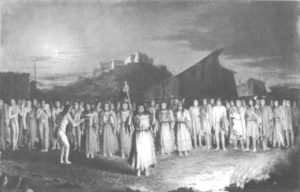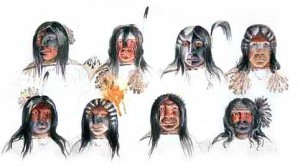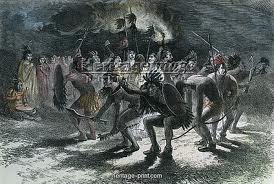Women were an integral part of tribal life; they raised and preserved food, cared for children, and accompanied men in battle when necessary. They participated in ceremonies and celebrations as well. Women were sole participants in certain dances, like the buckskin or cloth dance and squaw dance, but they joined men in many other dances.
When men returned successfully from war, the tribe celebrated with dancing. Both men and women participated in the Scalp Dance. Each tribe’s dance was somewhat different, but generally, scalps were brought into the village on long poles which were later decorated. The dancing was exuberant, but since it was a ceremony in a dance format, it followed a certain order and choreography. Medicine men sang and beat drums while women danced in concentric circles around the scalps. Sometimes dancers would mock the scalps or mimic hunting down the person to whom the scalp had belonged. When dancers were tired, a woman who had lost a male relative in battle would narrate the particulars of the battle and how her loved one had died. After that, she might ask “and now whose scalp do I have?” or if she had taken the scalp down to spread it across her shoulders she would say, “and now whose scalp is across my shoulders?” The sense of victory was an important component of the dance. The dance could continue at intervals for several days or weeks; eventually the scalp was buried or put on the death scaffold of a man who had helped take the scalp.
______________________________________________________________________________________


